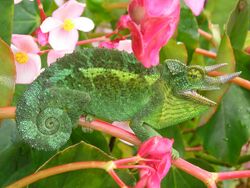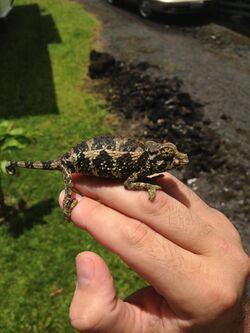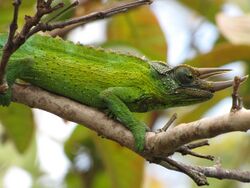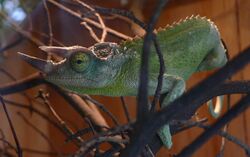Biology:Jackson's chameleon
| Jackson's chameleon | |
|---|---|

| |
| Male | |

| |
| Female | |
| Scientific classification | |
| Domain: | Eukaryota |
| Kingdom: | Animalia |
| Phylum: | Chordata |
| Class: | Reptilia |
| Order: | Squamata |
| Suborder: | Iguania |
| Family: | Chamaeleonidae |
| Genus: | Trioceros |
| Species: | T. jacksonii
|
| Binomial name | |
| Trioceros jacksonii (Boulenger, 1896)[2]
| |

| |
| Map highlighting countries inhabited by the Jackson's chameleon | |
| Synonyms | |
| |
Jackson's chameleon (Trioceros jacksonii), also known as Jackson's horned chameleon, three-horned chameleon or Kikuyu three-horned chameleon, is a species of chameleon (family Chamaeleonidae) native to East Africa, and introduced to Hawaii, Florida, and California .[1][3][4][5][6]
Taxonomy
Jackson's chameleon was described by Belgian-United Kingdom zoologist George Albert Boulenger in 1896.[2]
Etymology
The generic name, Trioceros, is derived from the Greek τρί- (tri-) meaning "three" and κέρας (kéras) meaning "horns".[7] This is in reference to the three horns found on the heads of males.
The specific name, jacksonii, is a Latinized form of English explorer and ornithologist Frederick John Jackson's last name, who was serving as the first Governor of Kenya at the time.[8][9]
The English word chameleon (also chamaeleon) derives from Latin chamaeleō, a borrowing of the Ancient Greek χαμαιλέων (khamailéōn), a compound of χαμαί (khamaí) "on the ground" and λέων (léōn) "lion". The Greek word is a calque translating the Akkadian nēš qaqqari, "ground lion".[10]
Subspecies
The three subspecies, including the nominate, are:
- T. j. jacksonii (Boulenger, 1896) – Jackson's chameleon
- T. j. merumontanus (Rand, 1958) – dwarf Jackson's chameleon
- T. j. xantholophus (Eason, Ferguson & Hebrard, 1988) – yellow-crested Jackson's chameleon
Habitat and geographic range
Jackson's chameleons are native to woodlands and forests at altitudes of 1,600 to 2,440 m (5,250 to 8,010 ft) in south-central Kenya and northern Tanzania.[4][11] In these areas, the rainfall is seasonal but exceeds 127 cm (50 in) per year. Day temperatures are typically 16–27 °C (61–81 °F), and night temperatures are typically 4–18 °C (39–64 °F).[11] In Tanzania, it is known only from Mount Meru in the Arusha Region, which is the home of the relatively small endemic subspecies T. j. merumontanus.[4] Jackson's chameleon is more widespread in Kenya, where it is even found in wooded areas of some Nairobi suburbs.[4]
The subspecies T. j. xantholophus (native to the Mount Kenya region) was introduced to Hawaii in 1972 and has since established populations on all main islands and became an invasive species there.[12][13][14][15] This subspecies has also been introduced to Florida.[5] In Hawaii, they are found mainly at altitudes of 100 to 1,000 m (330 to 3,280 ft) in wet, shady places.[5] Historically this population was the primary source of Jackson's chameleons for the exotic pet trade in the United States, but exports from Hawaii are now illegal.[5] This has been done to prevent opportunists from willfully establishing further feral animal populations to capture and sell them.[15]
Description
Jackson's chameleons are sometimes called three-horned chameleons because males possess three brown horns: one on the nose (the rostral horn) and one above each superior orbital ridge above the eyes (preocular horns), somewhat reminiscent of the ceratopsid dinosaur genus Triceratops. The females generally have no horns,[16] or instead have traces of the rostral horn (in the subspecies T. j. jacksonii and T. j. merumontanus). The coloring is usually bright green, with some individual animals having traces of blue and yellow, but like all chameleons, they change color quickly depending on mood, health, and temperature.
Adult males reach a total length (including tail) of up to 38 cm (15 in) and females up to 25 cm (10 in), but more typical lengths are 15 to 25 cm (6 to 10 in).[4] It has a saw-tooth shaped dorsal ridge and no gular crest. It attains sexual maturity after five months. The lifespan is variable, with males generally living longer than females.
The largest subspecies of Jackson's chameleon is T. j. xantholophus, which has been captively bred since the 1980s.[17]
Ecology
Feeding habits
Jackson's chameleons live primarily on a diet of small insects. They also prey on centipedes, isopods, millipedes, spiders, lizards, small birds, and snails in their native habitat.[13]
Invasive species
There is a threat of devastating impact of introduced invasive Jackson's chameleons to native ecosystems in Hawaii.[13] They were found with mainly insects in their stomachs: planthoppers Oliarus, grasshoppers Banza, casebearing caterpillars Hyposmocoma, beetles Oodemas, dragonflies Pantala[13] and others.[15] Holland et al. (2010)[13] proved that they also prey on snails in Hawaii.[13] Their prey includes land snails Achatinella, Auriculella, Lamellidea, Philonesia,[13] Oxychilus alliarius.[15] They are swallowing whole snails (including shells).[13] Jackson's chameleons introduced to Hawaii are a substantial threat to native biodiversity of invertebrates[15] and a serious threat especially to endemic species, such as critically endangered O'ahu tree snails (genus Achatinella).[13][14]
Territoriality
T. jacksonii are less territorial than most species of chameleons. Males will generally assert dominance over each other through color displays and posturing in an attempt to secure mating rights, but usually not to the point of physical fights.
Reproduction
Most chameleons are oviparous, but Jackson's chameleon and several other highland species in the genus Trioceros are ovoviviparous, giving birth to offspring soon after they are ready to hatch from their egg sac;[18][19] eight to thirty live young are born after a five- to six-month gestation. The subspecies T. j. merumontanus gives birth to five to ten live young.[20]
In captivity
In captivity, Jackson's chameleons require high humidity, and are in general very needy of colder temperatures during the night. Too much heat, or excessive humidity, can cause eye infections and upper respiratory infections in these animals. In captivity, the Jackson's chameleon can be expected to live between five and ten years.[21]
References
- ↑ 1.0 1.1 Tolley K (2014). "Trioceros jacksonii ". IUCN Red List of Threatened Species 2014: e.T172531A1344462. doi:10.2305/IUCN.UK.2014-3.RLTS.T172531A1344462.en. https://www.iucnredlist.org/species/172531/1344462. Retrieved 18 February 2022.
- ↑ 2.0 2.1 Boulenger, George Albert (1896). "Description of a new Chameleon from Uganda". Annals and Magazine of Natural History. Sixth Series 17 (101): 376. doi:10.1080/00222939608680383. https://zenodo.org/record/2086913. (Chamaeleon jacksonii, new species).
- ↑ 3.0 3.1 Trioceros jacksonii at the Reptarium.cz Reptile Database. Accessed 16 December 2015.
- ↑ 4.0 4.1 4.2 4.3 4.4 Spawls S, Howell K, Drewes RC, Ashe J (2002). A Field Guide to the Reptiles and Amphibian of East Africa. Academic Press. pp. 227-228. ISBN:0-12-656470-1
- ↑ 5.0 5.1 5.2 5.3 Global Invasive Species Database. (2010). Chamaeleo jacksonii (reptile) . Retrieved 16 November 2014.
- ↑ California Herps: A Guide to the Amphibians and Reptiles of California. [1]. Retrieved 20 April 2017.
- ↑ Liddell HG, Scott R (1980). Greek-English Lexicon, Abridged Edition. Oxford, United Kingdom: Oxford University Press. ISBN 978-0-19-910207-5. https://archive.org/details/lexicon00lidd.
- ↑ Le Berre, François; Bartlett, Richard D. (2009). The Chameleon Handbook. Barron's Educational Series. p. 3. ISBN 978-0-7641-4142-3.
- ↑ Beolens, Bo; Watkins, Michael; Grayson, Michael (2011). The Eponym Dictionary of Reptiles. Baltimore: Johns Hopkins University Press. xiii + 296 pp. ISBN:978-1-4214-0135-5. (Chamaeleo jacksonii, p. 132).
- ↑ Dictionary.com entry for "chameleon"
- ↑ 11.0 11.1 Waring GH (1996) Preliminary Study of the Behavior and Ecology of Jackson's Chameleon of Maui, Hawaii. Southern Illinois University. Retrieved 11 November 2014.
- ↑ "Jackson's chameleon (Chamaeleo jacksonii )". Hawaii Biodiversity Information Network. http://www.reportapest.org/pestlist/chajac.htm.
- ↑ 13.0 13.1 13.2 13.3 13.4 13.5 13.6 13.7 13.8 Holland BS, Montgomery SL, Costello V (2010). "A reptilian smoking gun: first record of invasive Jackson’s chameleon (Chamaeleo jacksonii ) predation on native Hawaiian species". Biodiversity and Conservation 19 (5): 1437-1441. doi:10.1007/s10531-009-9773-5.
- ↑ 14.0 14.1 Chiaverano LM, Holland BS (2014). "Impact of an invasive predatory lizard on the endangered Hawaiian tree snail Achatinella mustelina: a threat assessment". Endangered Species Research 24: 115-123. doi:10.3354/esr00589.
- ↑ 15.0 15.1 15.2 15.3 15.4 Kraus F, Preston D (2012). "Diet of the invasive lizard Chamaeleo jacksonii (Squamata: Chamaeleonidae) at a wetforest site in Hawaii". Pacific Science 66: 397-404. PDF.
- ↑ "Jackson's Chameleon". 2 December 2015. http://www.animalspot.net/jacksons-chameleon.html.
- ↑ Davison, Linda. "Jackson's Chameleon Care Sheet". Reptiles. http://www.reptilesmagazine.com/Care-Sheets/Lizards/Jacksons-Chameleon/. Retrieved May 30, 2018.
- ↑ Kundinger, Heather. "Jackson's chameleon". University of Michigan Museum of Zoology. http://animaldiversity.org/accounts/Chamaeleo_jacksonii/.
- ↑ Hughes, D.F.; Blackburn, D.G. (2020). "Evolutionary origins of viviparity in Chamaeleonidae". Journal of Zoological Systematics and Evolutionary Research 58 (1): 284–302. doi:10.1111/jzs.12328.
- ↑ admin (14 September 2019). "Jackson's Chameleon Care" (in en-US). https://chameleonacademy.com/jacksons-chameleon-care/.
- ↑ Exotic Pets section of About.com[yes|permanent dead link|dead link}}]
External links
- Trioceros jacksonii at the Reptarium.cz Reptile Database
- Jackson's Chameleon Care Information at Caresheets.net
- Chamaeleo jacksonii information from HEAR
- Preliminary study of the behavior and ecology of Jackson's chameleons of Maui, Hawaii (Dr. George H. Waring, Dept. of Zoology, Southern Illinois University)
Wikidata ☰ Q592680 entry
 |





